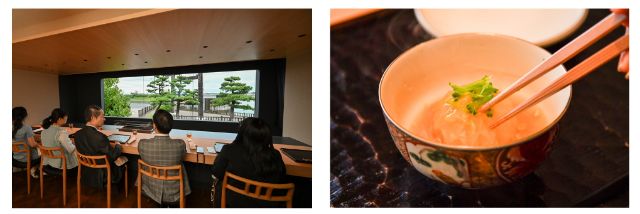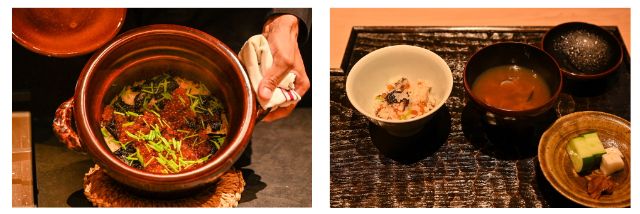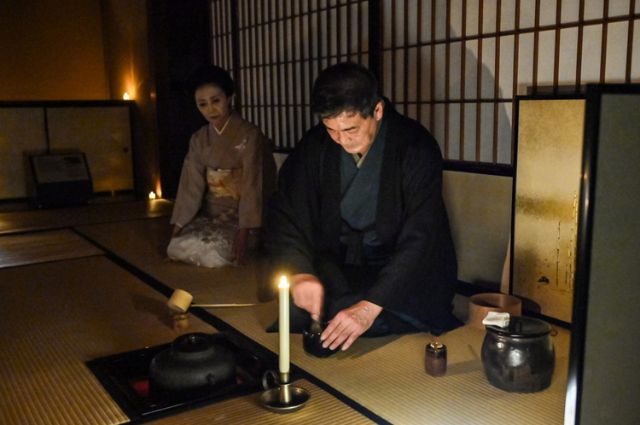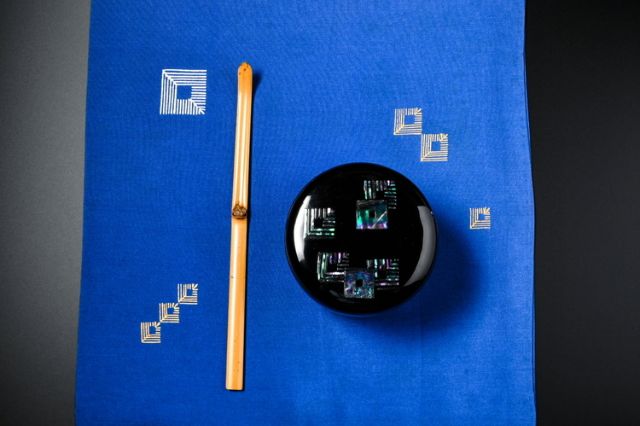Rokkaen, a nationally designated Important Cultural Property and rare architectural treasure from the Meiji and Taisho periods, will be specially illuminated for this event. Guests will have the unique opportunity to experience a nighttime tea ceremony by the Matsuo school of tea, which traces its origins back to its founder, Tsuji Gensai (birthdate unknown–1576).
The evening begins with a kaiseki meal at Kaiseki Ichino, showcasing the finest cuisine and heartfelt hospitality of Kuwana, designed to enhance the flavor of a single bowl of tea. Following this, guests will learn the art of enjoying tea from Master Myogensai Soten, the 12th head of the Matsuo school. The following report captures the essence of a truly extraordinary evening.
- Authentic Tea Kaiseki Cuisine: Created with care to enhance the flavor of tea and provide a truly unforgettable dining experience.
- An Open Kitchen with a Scenic View: Featuring the iconic Ichi no Torii gate as its stunning backdrop, guests will be captivated by its ambience.
- The Chidori Sakazuki Ritual: A symbolic exchange of cups between the host and guests steeped in tradition and meaning.
- Evening Tea Ceremony at the Illuminated Rokkaen: Experience the serene beauty of Rokkaen under the night lights.
- Koicha-seki Session in Ichinoma: Relish the tranquility while enjoying the deep, rich flavors of koicha in a peaceful setting.
- Interlude in the Garden and Thin Tea Session in Ninoma: Take a restful break in the garden before moving to a lighter usucha session, where conversation flows freely.
Authentic tea kaiseki: Created to enhance the enjoyment of tea
Standing at the ferry landing of Shichiri-no-Watashi is the Ise no Kuni Ichi Torii, the first torii gate in Ise Province. In the past, travelers from the eastern provinces would cross the sea route — the only one on the Tokaido — from Miya-no-Watashi (Atsuta Ward, Nagoya City, Aichi Prefecture) to Kuwana-no-Watashi (Kuwana City, Mie Prefecture) by boat. Passing through this torii gate marked their entry into Ise Province, making it a symbol of the eastern gateway to Ise.
Originally rooted in the desire to make tea more enjoyable, cha-kaiseki developed as a way to entertain guests with light meals and sake while waiting for the water to boil for tea.
On the day, a slightly early dinner will be served at Kaiseki Ichino starting at 5:00 p.m., timed perfectly to complement the goza (evening tea ceremony) at Rokkaen, which begins at 7:30 p.m. and includes both koicha (thick tea) and usucha (thin tea) sessions.
Left: Counter seating with a clear view of the majestic torii gate and the serene Ibi River through large windows. Right: Okousen, a delicacy seasoned with roasted salt and made from a blend of dried tangerine peel and various herbal ingredients.
Located near the Ise no Kuni Ichi Torii, Kaiseki Ichino welcomes guests with a serving of okousen, a beverage akin to a welcome drink. This herbal infusion, with a delicate flavor reminiscent of light kombu tea, gently soothes the throat and prepares the senses.
After enjoying this calming drink, guests settle into their seats at the counter, ready to immerse themselves in the experience.
An open kitchen with a captivating view of the iconic Ichi Torii
Left: Master Myogensai Soten, 12th-generation head of the Matsuo school. Right: A meal set consisting of maitake mushroom rice, taro soup, and kawahagi (filefish).
The kaiseki course begins with a meal set served by Master Myogensai Soten, the 12th-generation head of the Matsuo school.
Left: Matsutake mushrooms grilled over charcoal for a fragrant finish.
Right: The nimono-wan (simmered dish) features clam-shaped fish paste (shinjyo) with matsutake mushrooms.
The dish features seasonal delicacies, such as a soup with Kuwana’s famous clams paired with matsutake mushrooms and seared return bonito, allowing you to enjoy the flavors with both your eyes and your taste buds.
Left: Return bonito with a crispy sear on the skin.
Right: Seared return bonito served with a soy sauce jelly.
What further captivates the guests in addition to the delicious cooking is the open kitchen with the scenery of the first torii gate. Our tour participants, eager to capture dynamic photos of the action, excitedly snapped pictures of the food.
Left: Customers enjoying the local pride of abundant seafood from the brackish waters of Kuwana, along with other rich ingredients from Mie, while soaking in the beautiful scenery.
Right: The takiawase (vegetables served with meat, fish or tofu) features chrysanthemum-shaped radish and duck.
The main dish, served in the middle of the course, features abalone caught in Ise Bay and beef loin made using the renowned Mikumano beef from Mie Prefecture.
Left: The yakimono (grilled dish) features live abalone from Ise Bay, brought in while still alive.Right: The abalone, with just the right amount of chewiness and freshness, is served with a rich liver sauce full of the ocean’s aroma.
Left: The rare Mikumano beef raised exclusively at Okada Farm in Kumano City, Mie Prefecture.Right: The Mikumano beef loin, cooked for an hour, is tender and overflowing with clear meat juices.
An introduction to chidori sakazuki, where host and guests exchange cups
The head chef of Kaiseki Ichino is a skilled professional who, after training at a Kyoto restaurant, returned to his hometown of Kuwana wanting to help with local revitalization efforts.
The premium tour, unlike the regular course, features a specially crafted kaiseki meal designed to be enjoyed during a leisurely evening tea ceremony lasting four to five hours. While the sky is still bright at the beginning of the course, it gradually changes at dusk. This beautiful moment, suspended between day and night, is a special time that helps one forget the hustle and bustle of everyday life, and brings a sense of calm to the soul.
Left: The hashi-arai (chopstick wash) is a soup made with mukago (wild yam seeds), which is in season during autumn.Right: The hassun (appetizer sampler) features simmered sweetfish with roe and deep-fried chestnuts.
In kaiseki cuisine, hassun, which is served as an appetizer, refers to the dish served during the later stages of a tea ceremony, when the host and guest exchange cups. During the course, you will experience the chidori sakazuki, where the host, (in this instance Master Myogensai Soten) and each guest share cups.
When the host pours sake for the guest, the guest then pours a drink for the host. Helped by the host, everyone exchanges cups with each other. After finishing the drink, the same cup is passed around to all participants in the chidori sakazuki ritual. (For this tour, each participant uses a separate cup.) As the host drinks with each person, everyone has the chance to be amazed by the master’s drinking prowess.
Left: The oshokuji (main meal) is a rice dish with salmon roe.Right: Red miso soup and pickles. Finally, mizumono (Japanese dessert) featuring persimmons and Shine Muscat grapes is served, marking the end of the kaiseki.
At 7:00 p.m., when the surroundings have grown completely dark, the kaiseki concludes at Kaiseki Ichino. The group makes their way to Rokkaen, lighting the path with lanterns as they walk along the embankment. It is specially illuminated for this occasion.
With lanterns in hand, it takes about 10 minutes on foot from Kaiseki Ichino to Rokkaen
Experience the evening tea ceremony at the illuminated Rokkaen
Normally open only during the day, Rokkaen is specially illuminated for the premium tour
The highlight of this premium tour is the evening tea ceremony, yobanashi, held in the rear hall (goza). The venue is Rokkaen, a residence built for the second-generation businessman, Moroto Seiroku, who was known as the King of Forests. Construction began in 1911 and was completed in 1913. The sprawling 18,000㎡ grounds are home to a mix of Western and Japanese-style buildings, including warehouses (which are designated Important Cultural Properties) and a pond-style Japanese garden (which is a designated Special Scenic Site).
The Western-style building was designed by British architect Josiah Conder, renowned for designing the Rokumeikan, a social venue built in 1883 to entertain state guests and foreign diplomats. With this special illumination, these historic buildings from the Meiji and Taisho periods are bathed in light, creating a fantastic atmosphere.
![Especially illuminated! Experience an evening tea ceremony hosted by the Matsuo school at the beautifully lit Rokkaen in Kuwana, Mie Prefecture.]()
Left: The first-floor guest room of Rokkaen, a residence built for the second-generation businessman Moroto Seiroku, known as the King of Forests. Construction began in 1911 and was completed in 1913.Right: Tour participants are provided with the necessary items for the tea ceremony, including paper for wiping hands, a fan, toothpicks (for cutting sweets), and a case for the paper.
In the first-floor guest room, participants receive a lecture on how to properly enter the seating area (seki-iri) and prepare themselves by changing into white socks.
Preparations for the tea ceremony include setting phones to silent, removing accessories such as watches, rings, necklaces, earrings, and piercings to avoid damaging the tea utensils, and tying up long hair. These are all necessary steps for entering the tea ceremony space.
Koicha-seki: Enjoying the tranquility in the ichi no-ma with thick tea
Once guests are prepared both physically and mentally, they head to the ichi no-ma in the Japanese-style building for the koicha-seki (thick tea ceremony). The thick tea, made with high-quality matcha and prepared with a small amount of hot water, is characterized by its rich flavor and strong aroma.
Left: The ichi no-ma in the Japanese-style building, designated as an Important Cultural Property. Right: Enjoying the evening tea ceremony, yobanashi, by candlelight.
The evening tea ceremony experience, yobanashi, takes place during the period of long, dark nights (autumn to winter). The ceremony is held after dusk, illuminated only by candlelight. It has traditionally been a tea ceremony held to enjoy these seeminly unending nights.
The Japanese sweets served with the thick tea are seasonal namagashi from Kashi-dokoro Kazu in Kuwana
The tea is served by Master Myogen Saimon, the 12th generation head of the Matsuo school, following the tradition of the school’s founder, Tsuji Gensai (birthdate unknown – 1576). During the koicha-seki, conversation is prohibited until drinking the tea. The koicha, enjoyed in silence and soft candlelight, allows for a deep, mindful tasting experience, and the wordless time feels remarkably soothing.
The techniques of the master, which captivate observers with each step, are showcased during the ceremony. The utensils and tea tools used in the koicha-seki are said to be of deep historical significance. The tea bowl for the thick tea was created by the sixth generation of the “Rakuke” family, Sanyu, and is inscribed with the name “Matsuno-yu,” given by the head of the Matsuo school, who was the eighth predecessor of Master Myogensai Soten.
Usucha-seki: Enjoying conversation in the ni no-ma
Rokkaen as seen from the inner garden
Once the thick tea ceremony concludes, participants move into the nakadachi (break period) and step outside the room for a rest in the garden. Afterward, guided by the sound of musical instruments, they move to the ni no-ma (second room) for the usucha-seki.
In contrast to the koicha-seki, the usucha-seki allows for conversation, which creates an easy-going atmosphere. Participants then spend some time conversing with Master Myogensai Soten.
Left: The ni no-ma in the Japanese-style building. Right: The seasonal half-sweets served with the usucha are from Hanoya in Kuwana. The tea bowl is oinasu, inspired by the color of eggplant.
“Feel free to relax your posture,” Master Myogensai Soten told us, in a surprisingly warm and friendly tone.
So, what are the basic rules that must be followed when enjoying a tea ceremony?
“For me, tea utensils and tools are very important. As long as you treat them with the same care, there are basically no overly complex rules. Holding tea utensils too high or using them with one hand can cause the host to worry, as they might get dropped. Rings and necklaces can also cause damage by striking the tea bowl. As long as you follow the basic etiquette of not making the host anxious, there should be no issues.”
The host shows consideration for the guests, and likewise, the guests show consideration for the host. In this experience, we were able to catch a glimpse of the world of tea ceremonies, where both parties consider each other.
The tea utensils for the usucha-seki. The natsume (tea caddy) is adorned with the Matsuo school crest, inlaid with blue shell.
In the precious space designated as a national important cultural property, this premium tour offers a full-course omotenashi experience through the evening tea ceremony, yobanashi. Beginning with lavish kaiseki cuisine, participants enjoy the illuminated embankment and the photogenic Rokkaen, which is usually not accessible, creating an exhilarating atmosphere akin to a festival.
The tone shifts as the ceremony transitions, allowing participants to appreciate the thoughtful spirit and profound atmosphere of a cup of tea, leaving a night that will be deeply etched in memory, accompanied by a sense of spiritual fulfillment.
Click here for more details and booking:https://www.pelago.com/en/activity/phc039cer-discover-the-beauty-of-kuwana-and-mie-prefecture-on-special-tours-nagoya/This will take you to the Pelago by Singapore Airlines website.
Photography by Fumihiro Itabashi
Reporting, Text, and Editing by Aki Fujii
Disclaimer: All information is accurate at time of publication.





























![[Osaka Castle, Dotonbori, Tsutenkaku] Enjoy the Sights and Flavors of Osaka in One Day](/gg/content_image/%2Fimage%2Fdiscover_oishii_japan%2F699%2Farticle_head_150x105z.jpg)


![Azabudai Hills [SUMI] (Janu Tokyo) ~ Editor's Afterword by the Editor-in-Chief of Japan's Gourmet Site](/gg/content_image//image/discover_oishii_japan/6536/article_head_150x105z.jpg)









